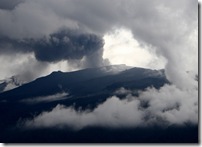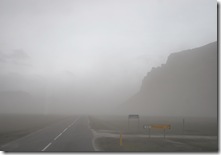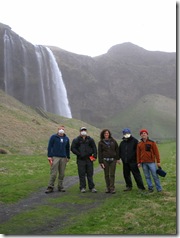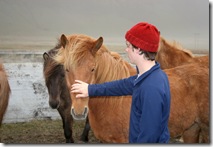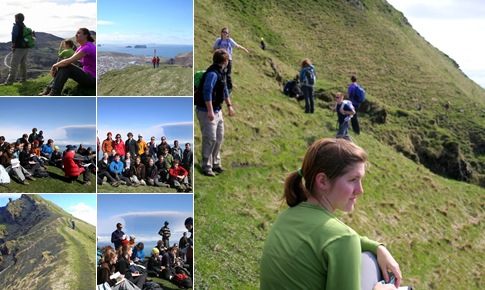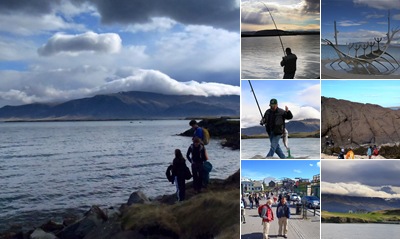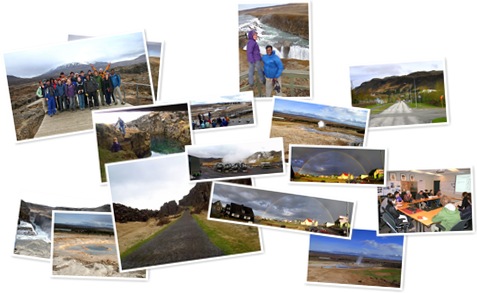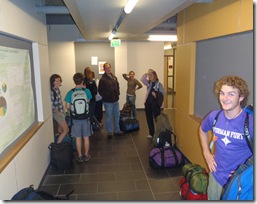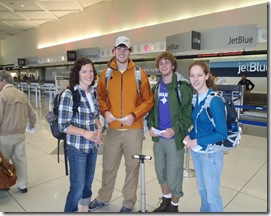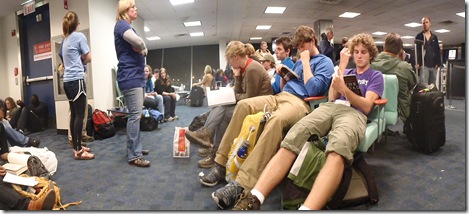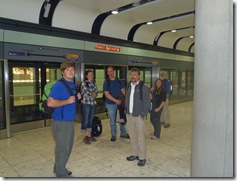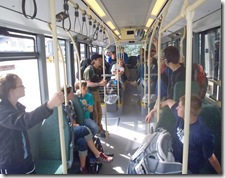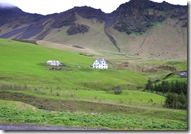 We left Hvoll hostel at 8 AM and headed to our next hostel destination, which is Borgarnes, a small city located along the western fjords. Students were very interested in the Wool Factory located in Vik, so, we made a stop there. We also had to pick up few items that were left behind at the hostel in Vik (photo on left) where we stayed last. Our guide Sveinborg accompanied us until the wool factory and parted her way to Reykjavik.
We left Hvoll hostel at 8 AM and headed to our next hostel destination, which is Borgarnes, a small city located along the western fjords. Students were very interested in the Wool Factory located in Vik, so, we made a stop there. We also had to pick up few items that were left behind at the hostel in Vik (photo on left) where we stayed last. Our guide Sveinborg accompanied us until the wool factory and parted her way to Reykjavik.
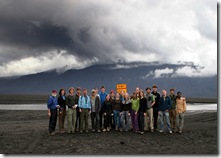 We talked our driver into driving us closer to the erupting volcano in order to get a closer view of eruption. So he took us as far as the bus could go, which in this case was where the road ends on a river bed. To go beyond, we needed special vehicles that can be driven through several miles of broad and soft river bed. The view of the eruption was really good. We took lots of pictures, and collected some ash samples. Luckily, it started getting cloudy and covered the view of the eruption completely just about the time we were leaving. We really were lucky to be there at the right time to use the short window of opportunity!
We talked our driver into driving us closer to the erupting volcano in order to get a closer view of eruption. So he took us as far as the bus could go, which in this case was where the road ends on a river bed. To go beyond, we needed special vehicles that can be driven through several miles of broad and soft river bed. The view of the eruption was really good. We took lots of pictures, and collected some ash samples. Luckily, it started getting cloudy and covered the view of the eruption completely just about the time we were leaving. We really were lucky to be there at the right time to use the short window of opportunity!
We stopped for lunch at a gas station (fast food, but much better quality than we have in the United States) and continued our journey across Iceland to the western peninsula. Most of us had opportunity to take short naps through the scenic journey. We took country side roads through Thingvillier National Park, where it started become very mountainous. I believe the driver chose to take this route (which is usually closed until summer time) because it is very scenic and has lots of cool geology. However, when we were about 40 minutes away from our destination, we encountered a debris slide that has come down all the way from atop the slope of the mountains and ran over the road. 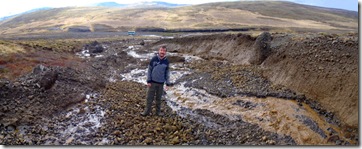 It was pretty wide at the point it intersected the road (more than 100 feet) and it appeared to have happened overnight during heavy rain, so it still had lots of mud and debris that were unstable. This meant, we had to turn around and drive back through different road, which added about an hour and half to our journey. It was nothing to complain about, but just another great opportunity for us and our students to see the geological forces at work.
It was pretty wide at the point it intersected the road (more than 100 feet) and it appeared to have happened overnight during heavy rain, so it still had lots of mud and debris that were unstable. This meant, we had to turn around and drive back through different road, which added about an hour and half to our journey. It was nothing to complain about, but just another great opportunity for us and our students to see the geological forces at work.
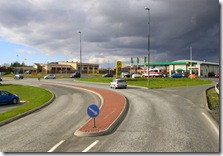 We reached the Borgarnes hostel and got checked in. There was a Pilipino restaurant and bar in town that was highly recommended for us. We called in and requested them to serve us a buffet, which they agreed to happily. We enjoyed the food and went to bed, while most of the students went to participate in a local meeting that was related to upcoming election in town. They said there were live bands after the meeting, and got to interact with college age local folks. The one thing that was missing in this trip (interaction with locals) so far was rectified at this place. Both our students and the Icelandic folks really meeting each other.
We reached the Borgarnes hostel and got checked in. There was a Pilipino restaurant and bar in town that was highly recommended for us. We called in and requested them to serve us a buffet, which they agreed to happily. We enjoyed the food and went to bed, while most of the students went to participate in a local meeting that was related to upcoming election in town. They said there were live bands after the meeting, and got to interact with college age local folks. The one thing that was missing in this trip (interaction with locals) so far was rectified at this place. Both our students and the Icelandic folks really meeting each other.
